|
We have been shocked and saddened by the several fatal escalator or lift accidents on the Mainland recently. Then, last week, there were escalator incidents at Times Square in Causeway Bay and Tai Wo Plaza in Tai Po, with foreign objects and the wheels of a pram getting jammed in the comb plates of the respective escalators. Although no one was injured in the incidents, they have aroused public concern over escalator safety in Hong Kong.
In light of such concerns, the Electrical and Mechanical Services Department (EMSD) has stepped up its safety inspections of escalators and lifts in the territory. At the end of last month, the EMSD issued a circular to the industry to remind registered contractors and engineers for lifts and escalators to check whether their inspection covers and floor plates, supporting structures and protective devices are in good working condition. The EMSD also issued letters to the Hong Kong Association of Property Management Companies Limited and the Building Services Operation and Maintenance Executives Society to remind their members that, as the persons responsible for escalators, they should inspect the working condition of escalators on a regular basis. Should any defects or anomalies be found, they should stop the escalator concerned immediately, fence off the area to prevent the public from using it, and inform the registered escalator contractor to follow up as soon as possible.
To address public concern, I would like to briefly explain the current monitoring mechanism for lift and escalator safety in Hong Kong. Under the Lifts and Escalators Ordinance, the installation, maintenance and repair of lifts and escalators in Hong Kong shall be carried out by registered lift/escalator contractors, with regular maintenance carried out by registered lift/escalator workers at least once a month. In addition, lifts and escalators have to undergo regular inspection by registered lift/escalator engineers at least once every 12 months and six months respectively to ensure their safe operation.
The design of lifts and escalators has to comply with the requirements set out in the Code of Practice on the Design and Construction of Lifts and Escalators (CoP) by the EMSD. In general, space will be reserved for repair and maintenance under the inspection covers and floor plates of an escalator. According to the current CoP, these inspection covers and floor plates should have sufficient mechanical strength and be built appropriately to prevent loosening or deformation after prolonged use. In addition, the CoP also requires an escalator to be equipped with (1) safety devices so that the escalator will stop automatically if the inspection covers and floor plates are opened; and (2) protective covers to prevent anyone from touching the dangerous rotating parts inside the maintenance space. When registered contractors and engineers carry out regular maintenance and inspection for the escalators, they will also ensure that the inspection covers and floor plates are in safe conditions.
Furthermore, before commencing installation works, registered contractors have to apply to the EMSD for type approval with regard to the brands and models of the lifts or escalators, as well as the safety components to be used. The EMSD will examine the information on the manufacturers of the equipment, product specifications, drawings, as well as related certificates issued by the testing institutes to ensure that the quality of the lifts and escalators in Hong Kong meet the recognised international safety standards. The Code of Practice for Lift Works and Escalator Works also stipulates that repair or replacement should be made with parts of at least equivalent material, strength, and design to maintain the lift or escalator in good working order. According to the EMSD’s record, none of the escalators manufactured by Suzhou Shenlong Elevator Company Limited, which was involved in the escalator accident in Jingzhou, Hubei, are installed in Hong Kong.
Moreover, under the Lifts and Escalators Ordinance, should there be serious escalator incidents, including those involving injuries or deaths, or any other serious incidents resulting from major component failures, the person/s responsible for the escalators must, within 24 hours after the incident comes to their knowledge, notify the EMSD. From 2013 to June this year, a total of about 3 800 escalator incidents were reported to the EMSD, the majority of which were due to careless use by passengers, or foreign objects getting lodged in the escalators. For instance, the two “accordion-style” escalator crash incidents at the Mong Kok and Wong Tai Sin MTR Stations last March and May were due to damage to the steps, respectively caused by small metal objects and shoes getting stuck in the comb plates of the escalators, rather than component failures. During the same period, there were six escalator incidents caused by component failures, with 10 people injured.
Lastly, here are seven basic rules for using an escalator to protect your own safety: (1) do not use trolleys, prams, bicycles or wheelchairs on the escalator; (2) do not use the lift if you are mobility handicapped or carrying large objects; (3) children must be accompanied by adults; (4) hold the handrail tightly and do not run or play; (5) keep your feet from the gaps between the steps and the gaps between the escalator skirtings and the steps, particularly when you are wearing cloth shoes or footwear with open toes, and do not touch the brush bristles of the skirtings so as to avoid getting your shoes or feet caught in the gaps; (6) keep your feet away from the skirtings or yellow stripes; (7) lift your foot when stepping on and off the escalator to avoid losing your balance and getting the front of your shoes trapped.
Wish you all a safe journey.
|
|
|
|
|
The general structure of an escalator
|
|
|
1. Inspection cover and floor plate safety devices
Safety devices are installed for the inspection covers and floor plates leading towards the steps of the escalator. |
|
|
2. Deflector device
Brush bristles are placed on the skirtings to reduce the danger of foreign objects being trapped between the skirtings and the steps, and to protect passengers’ feet. |
|
|
3. Skirting safety device
If foreign objects are trapped between the skirtings and the steps, the device will stop the escalator. |
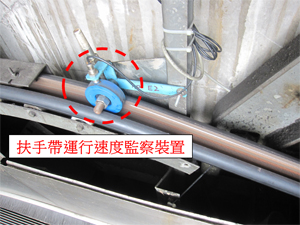 |
4. Handrail speed monitoring device
If the operating speed of the handrail exceeds a certain threshold, the device will stop the escalator. |
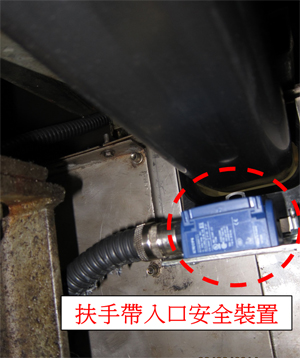 |
5. Handrail inlet safety device
If the handrail inlet becomes jammed with foreign objects, the device will stop the escalator. |
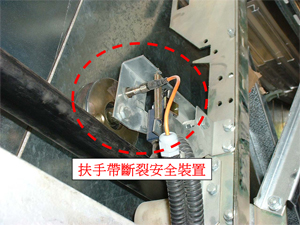 |
6. Broken handrail safety device
If a broken handrail is detected, the device will stop the escalator. |
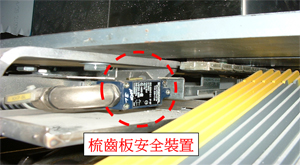 |
7. Comb plate safety device
If the space where the steps, pallets or belts enter the comb plates becomes jammed with foreign objects, the device will stop the escalator. |
|
|
8. Step-sagging safety device
If any part of the steps, pallets or belts is sagging and cannot be maintained in mesh with the inlet and outlet of the comb plates, the device will stop the escalator. |
|
|
9. Broken step chain safety device
If any breakage or undue elongation of the chains of the steps, pallets or belts is detected, the device will stop the escalator. |
|
|
10. Missing step safety device
It is installed at each driving and return station of the escalator. If there are any steps or pallets missing, the device will stop the escalator. |
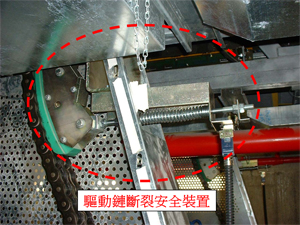 |
11. Broken drive chain safety device
If any breakage or undue elongation of the drive chain is detected, the device will stop the escalator. |
|
|
12. Overspeed governor
If the operating speed of the escalator exceeds a certain limit, the overspeed governor will cut off the power supply, thus stopping the escalator. |
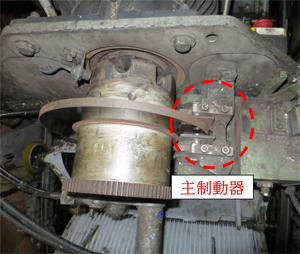 |
13. Main brake
In case of incidents such as trapping of foreign objects at the space where the steps, pallets or belts enter the comb plates, or in the gaps between the skirtings and the steps, the main brake will be actuated to stop the escalator. |
|
|
14. Auxiliary brake
In addition to the main brake, the auxiliary brake will assist in stopping the escalator under specific circumstances. |
|
|
15. Emergency stopping device
Usually installed at the entrance and exit of the escalator, or in other conspicuous and easily accessible positions at or near to the landings of the escalator. The escalator can be stopped by pressing the device button in case of emergency. |
|